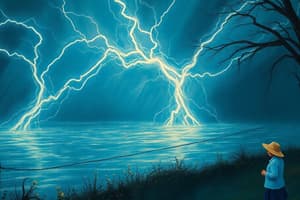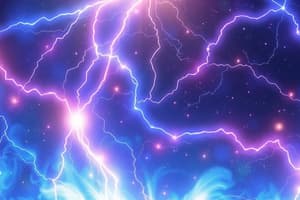Podcast
Questions and Answers
?
?
- (correct)
(EMF) ?
(EMF) ?
- (correct)
(Transformer) ?
(Transformer) ?
- (correct)
, ?
, ?
Flashcards
மின்காந்த விசை என்றால் என்ன?
மின்காந்த விசை என்றால் என்ன?
மின்னூட்டத் துகள்களுக்கு இடையே செயல்படும் விசை.
மின்சாரம் என்றால் என்ன?
மின்சாரம் என்றால் என்ன?
ஒரு கடத்தி வழியாக மின்னூட்டங்களின் ஓட்டம்.
காந்தப்புலம் என்றால் என்ன?
காந்தப்புலம் என்றால் என்ன?
நகரும் மின்னூட்ட துகள்களால் உருவாகும் விசை.
மின்காந்த தூண்டல் என்றால் என்ன?
மின்காந்த தூண்டல் என்றால் என்ன?
Signup and view all the flashcards
மேக்ஸ்வெல்லின் சமன்பாடுகள் என்றால் என்ன?
மேக்ஸ்வெல்லின் சமன்பாடுகள் என்றால் என்ன?
Signup and view all the flashcards
மின்காந்த அலைகள் என்றால் என்ன?
மின்காந்த அலைகள் என்றால் என்ன?
Signup and view all the flashcards
மின்சாரம் மற்றும் காந்தவியல் இடையே உள்ள தொடர்பு என்ன?
மின்சாரம் மற்றும் காந்தவியல் இடையே உள்ள தொடர்பு என்ன?
Signup and view all the flashcards
மின் காந்தங்கள் என்றால் என்ன?
மின் காந்தங்கள் என்றால் என்ன?
Signup and view all the flashcards
மின் அழுத்தம் என்றால் என்ன?
மின் அழுத்தம் என்றால் என்ன?
Signup and view all the flashcards
காந்தவியல் விசை என்றால் என்ன?
காந்தவியல் விசை என்றால் என்ன?
Signup and view all the flashcards
Study Notes
- Electromagnetism is a fundamental force of nature that describes the interaction between electrically charged particles
Electromagnetic Force
- It acts between charged particles
- It is the force that causes like-charged substances to repel and oppositely charged substances to attract
- It is a long-range force
- It is responsible for many of the phenomena of daily life
Electric Charge
- It is a fundamental property of matter that causes it to experience a force when placed in an electromagnetic field
- Electric charge can be positive or negative
- Like charges repel each other, and opposite charges attract each other
- The SI unit of electric charge is the coulomb (C)
Electric Field
- It is a region of space around an electrically charged object in which a force would be exerted on other electrically charged objects
- Electric fields are produced by electric charges
- The electric field is a vector field
- The direction of the electric field is the direction of the force that would be exerted on a positive charge placed in the field
- The SI unit of electric field strength is volts per meter (V/m) or newtons per coulomb (N/C)
Electric Potential
- It is the electric potential energy per unit charge at a specific location
- It is a scalar quantity
- The SI unit of electric potential is the volt (V)
- Electric potential difference is commonly referred to as voltage
Electric Current
- It is the rate of flow of electric charge through a conductor
- It is typically carried by electrons moving through a wire
- The SI unit of electric current is the ampere (A), which is equal to one coulomb per second
Magnetism
- It is a force of attraction or repulsion that arises between electrically charged particles because of their motion
- Magnetic fields are produced by moving electric charges
- The magnetic field is a vector field
- The direction of the magnetic field is the direction of the force that would be exerted on a moving positive charge placed in the field
- The SI unit of magnetic field strength is the tesla (T)
Magnetic Force
- It is the force exerted on a moving charge within a magnetic field
- The magnetic force is perpendicular to both the velocity of the charge and the magnetic field
- It is responsible for phenomena such as the deflection of charged particles in magnetic fields and the operation of electric motors
Electromagnets
- They are a type of magnet in which the magnetic field is produced by an electric current
- They are typically made by winding a wire into a coil
- They can be turned on and off by controlling the electric current
- They are used in a wide variety of applications, such as electric motors, generators, and magnetic levitation trains
Electromagnetic Induction
- It is the production of an electromotive force (EMF) across an electrical conductor in a changing magnetic field
- This phenomenon is described by Faraday's law of induction
- It is the principle behind the operation of electrical generators, transformers, and inductors
Maxwell's Equations
- They are a set of four equations that describe the behavior of electric and magnetic fields
- Gauss's law for electricity relates the electric field to the distribution of electric charges
- Gauss's law for magnetism states that there are no magnetic monopoles
- Faraday's law of induction relates a changing magnetic field to an electric field
- Ampere's law relates a magnetic field to an electric current and a changing electric field
- They are the foundation of classical electromagnetism
- They explain a wide range of phenomena, including the behavior of light and radio waves
Electromagnetic Waves
- They are disturbances in electric and magnetic fields that propagate through space
- They are created by accelerating electric charges
- They are transverse waves
- They consist of oscillating electric and magnetic fields that are perpendicular to each other and to the direction of propagation
- They travel at the speed of light in a vacuum
- They include radio waves, microwaves, infrared radiation, visible light, ultraviolet radiation, X-rays, and gamma rays
Relationship Between Electricity and Magnetism
- Electricity and magnetism are two aspects of the same fundamental force, electromagnetism
- A changing electric field creates a magnetic field, and a changing magnetic field creates an electric field
- This relationship is described by Maxwell's equations
Applications of Electromagnetism
- Electric motors convert electrical energy into mechanical energy using the interaction between magnetic fields and electric currents
- Generators convert mechanical energy into electrical energy using electromagnetic induction
- Transformers are used to increase or decrease the voltage of alternating current (AC) electricity, enabling efficient power transmission over long distances
- Radio waves are used for wireless communication, broadcasting, and radar
- Microwaves are used for cooking, communication, and radar
- Medical imaging techniques such as MRI (magnetic resonance imaging) rely on strong magnetic fields and radio waves to create detailed images of the human body
Studying That Suits You
Use AI to generate personalized quizzes and flashcards to suit your learning preferences.




